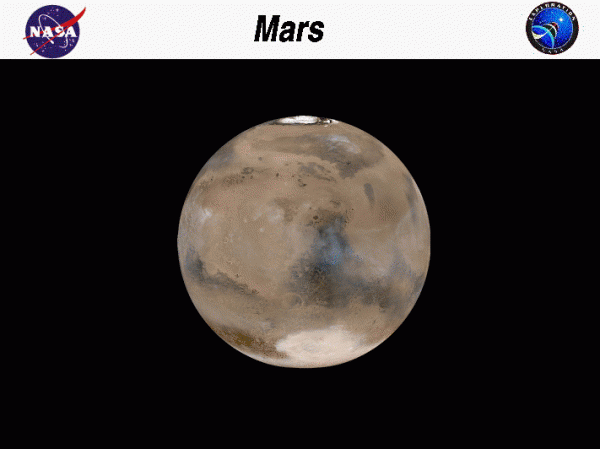Mars

Mars
Mars is the fourth planet from the Sun and orbits the Sun at an average distance of approximately 141 million miles (225 million km). It rotates on its axis, completing one revolution every 24.6 hours. The axis of Mars is tilted at 25 degrees and 12 minutes relative to its orbital plane about the Sun. This produces seasons on the surface of Mars, similar to the seasons on Earth. Mars completes one orbital revolution around the Sun every 1.88 Earth years. Two small natural satellites, Demos and Phobos, orbit Mars. Mars has no magnetic field to protect the surface from radiation from the Sun.
Mars Resembles Earth
Many of the features on the surface of Mars resemble features on the Earth; there are great dusty plains, there are large volcanoes, and there is a large rift valley along the equator. Similar to the Earth, Mars has ice caps at the poles which grow and shrink with the seasons. There are surface features which suggest that liquid water once flowed across the surface of Mars, but there are no current lakes or rivers of liquid water on the surface. As on Earth, water or water ice may be present underground.
The mass of Mars is approximately 7.1 x 1020 tons (6.4 x 1023 kg or .11 x Earth mass). The mean diameter of Mars is 4,217 miles (6,785 km or .53 x Earth diameter). The resulting surface gravitational acceleration (gmr) is given by:
\(\LARGE \mathit{gmr}=12.1\frac{\text{ft}}{\text{sec}^{2}}=3.7\frac{\text{m}}{\text{sec}^{2}}=.37\enspace\text{Earth gravity}\)
Atmosphere of Mars
Mars has a thin atmosphere composed almost entirely of carbon dioxide. As on Earth, the atmosphere is in constant motion and large dust storms have been observed from orbit. The recent Martian rovers photographed multiple dust devils passing the craft on the surface. The thin atmosphere provides little shielding from radiation from the Sun. Temperature extremes on the surface of Mars range from -200 degrees to 32 degrees F. The atmosphere will cause aerodynamic drag on a rocket launched from the surface going into orbit around Mars. The atmosphere also provides a means for slowing spacecraft as they land on the surface. All of the spacecraft that have landed on Mars have used parachutes during part of their descent through the atmosphere. The pressure, temperature, and density of the atmosphere all decrease with altitude above the Martian surface.
Robotic Race to Mars
The robotic exploration of Mars began in the mid 1960’s with the Mariner series of spacecraft. The early Mariner’s took detailed pictures and measurements of the planet as the spacecraft flew past. Mariner 9 was the first spacecraft to go into a permanent orbit around Mars. The two Viking spacecraft went into Martian orbit in the mid-1970’s and each sent a soft lander down to the planet’s surface. Since the 1980’s, a series of orbiting and landing spacecraft have been sent to Mars. Details of these missions are available at the Mars Exploration web site.
